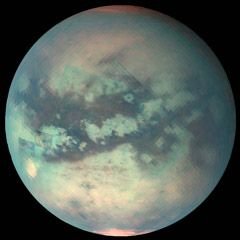Titan
Saturn's largest moon, Titan, is the second largest moon in our solar system—Jupiter's Ganymede is only 2 percent larger. Titan is bigger than Earth's Moon, and even larger than the planet Mercury.

Titan is the only moon in our solar system that has clouds and a dense atmosphere, mostly made of nitrogen and methane. It is also the only other place in the solar system known to have an earthlike cycle of liquids evaporating, raining and flowing across its surface. But on Titan, instead of water, the clouds, rain, rivers, seas and lakes are made of liquid hydrocarbons. The moon’s surface is icy, at hundreds of degrees below freezing. Large regions are covered in dunes made of hydrocarbon “sand” that has settled out of the hazy, smoggy atmosphere.
The name Titan comes from a generic term for the powerful children of Uranus and Gaia (or Earth) in ancient Greek mythology. Several of Saturn’s other moons are named for specific Titans
Discovery
Titan was discovered on Mar. 27, 1655 by the Dutch astronomer Christiaan Huygens.
Overview
Saturn's largest moon Titan is the second largest moon in our solar system, second only to Jupiter's Ganymede, which is only 2 percent larger. With a mean radius of 1,600 miles (2,575 km), Titan is bigger than Earth's moon, and even larger than the planet Mercury.
Titan is the only moon in our solar system that has clouds and a dense atmosphere, mostly nitrogen and methane. It is also the only other place in the solar system known to have an earthlike cycle of liquids flowing across its surface.
Orbit
Titan orbits Saturn at a distance of about 759,000 miles (1.2 million km), taking 15 days and 22 hours to complete a full orbit. Titan is tidally locked in synchronous rotation with Saturn, and permanently presents one face to the planet as it completes its orbit.
Surface
Cassini has revealed that Titan's surface is shaped by rivers and lakes of liquid ethane and methane (the main component of natural gas). These liquids form clouds from which the liquid gases sometimes rain from the sky as water does on Earth.
Ligeia Mare
Ligeia Mare, shown here in a false-color image from NASA's Cassini mission, is the second largest known body of liquid on Saturn's moon Titan. It is filled with liquid hydrocarbons, such as ethane and methane, and is one of the many seas and lakes that bejewel Titan's north polar region. Credit: NASA/JPL-Caltech/ASI/Cornell
On Titan it is so cold (-290 degrees Fahrenheit or -179 degrees Celsius) that water plays the role of rock and lava, and flowing methane carves river channels and fills great lakes with liquid natural gas. Vast regions of tall dunes stretch across the landscape -- dunes whose "sand" is composed of dark hydrocarbon grains. The dunes are not unlike those seen in the desert of Namibia in Africa. Volcanism may occur as well, but with liquid water as the lava.
Titan has few impact craters, meaning that its surface must be relatively young and some combination of processes erases evidence of impacts. This is the case for Earth as well; craters on our planet are eroded by the relentless forces of flowing liquid (water, in Earth's case) and wind. These forces are present on Titan as well. Tectonic forces -- the movement of the ground due to pressures from beneath -- also appear to be at work on Saturn's largest moon.
Credit: NASA
Photo: NASA's Cassini Mission
For more information: https://solarsystem.nasa.gov/moons/saturn-moons/titan/in-depth/
Reply to my last blog post everytime you make a blog post and I will upvote and resteem it for free to my 36,000+ followers. @a-0-0